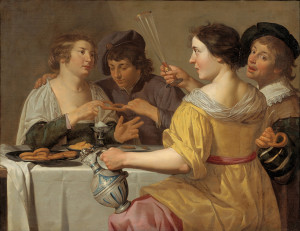By now, we are one week into Lent, into our journey of forty days. In Italy, the season of Lent is known as Quaresima, which sounds not at all as spare as its English counterpart. It sounds almost celebratory, doesn’t it? But don’t let the name fool you: The traditional image for Quaresima is an old hag, gaunt and thin, which is in stark contrast to the traditional image for Carnevale, a rather robust and rotund man with a necklace of sausages dangling from his head. But there is wisdom in these depictions: the Carnival season is certainly about excess. By the Lenten season, it was time to make do with what was left in the larder, which, by now, was very often not much… even well into the 20th century.
Even now, I am not one to buy fruits and vegetables that are out of season, shipped in from another hemisphere. Yes, we can buy peaches and cherries even in February… but I just can’t. I love peaches and cherries, but there is something about eating them in their proper time that makes them special. Having them at any old time of year reduces these seasonal delights into commonplace everyday commodities, rendering them not as special.
But I digress. We were talking about Lent. The forty days of Lent are meant to mirror Jesus’s forty days of fasting in the desert. It was Pope Gregory I who began the rule on abstaining from meat and things of the flesh (milk, cheese, eggs) in the late 6th century. This is why we dye eggs at Easter––it was traditionally done in celebration of being able to eat them again. Things were pretty strict early on, but over the centuries, have loosened to the point that now, most Catholics just abstain from meat on Fridays during Lent.
Being a time of spare solemness, it is not surprising that there are not many celebratory foods that accompany Lent. There is one, however: The humble pretzel. At their most basic, pretzels are made with just three ingredients, all Lenten-friendly: flour, salt, and water. It is thought that the name “pretzel” is derived from the Latin bracellae: “little arms,” essentially, evoking the prayer posture of early Christians, who prayed with their arms crossed over the chest. Go ahead, try it right now, then look down at your chest: class pretzel shape. This penitential bread––again, so common nowadays so as to be nothing special––has a history that goes back many many centuries. The first pretzels were thought to be made in the 6th century. Some historians think they go back three centuries more.
Connections like these are, I think, so fascinating. That a common pretzel can have such interesting roots (and deep ones, at that) and can have a connection to celebratory days (or penitential ones, in this case) is such a wonderful thing.
Image: Het trekken aan de krakeling (Pulling of the Pretzel) by Jan van Biljert, oil on canvas, c. 1630, [Public domain], via Wikimedia Commons.

I am with you – “for everything there is a season . . .” – for every fruit, too 🙂
Always enjoying your postings!